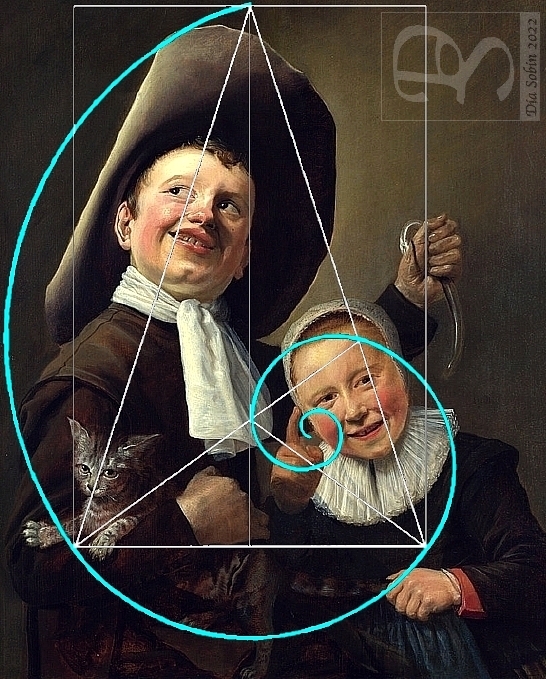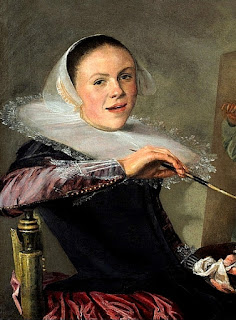 | ||
| A Boy and a Girl with a Cat and an Eel, 1635, Judith Leyster. Geometry: 2022, DS. |
"Artist Judith Leyster wanted to follow her star as a painter.
Her name even spelled it out - Leystar means "lodestar" or guiding star
in Dutch. When she signed a painting, Judith made a visual pun, adding a
JL monogram and attaching a star to it.
Born in 1609 in Haarlem,
Judith won wide acclaim in her time - a reputation that went into
eclipse at her marriage and, by her death (around 1668), had vanished
almost completely. Funny, just like many of her paintings..."
- Via Uppity Women of the Renaissance,
1999, Vicki Leon. Leon is referring to the fact that after Leyster's
death her paintings were not identified for 200 years - and attributed
to a male artist instead - despite the fact that her signature was
present. In other words, that story... and we've heard it before.
"A Boy and a Girl with a Cat and an Eel is a 1635 oil painting by Judith Leyster that is now in the National Gallery, London.
Academic interpretation
There have been various interpretations of Judith Leyster's A Boy and a Girl with a Cat and an Eel by different scholars. Some, such as Neil McLaren, have argued that it represents the Dutch proverb "Een aal bij de staart hebben" (or "to hold an eel by the tail") meaning that you do not get to hold onto something just because you have it. This moralistic interpretation is supported, Cynthia Kortenhorst-Von Bogendorff Rupprath says, by the eye contact with the viewer made by the little girl in the painting as she wags her finger."
- Via the Wiki entry for the painting by Judith Leyster ((July 28, 1609 – February 10, 1660) above. Of course, this interpretation doesn't really fly... that is, if anyone (who isn't blind-folded) actually looks at the painting. For instance, does the woman (inset right) look remotely like a little girl? True, she is quite small and Leyster refers to her as a "girl," but if you look at the skin on her face and hands, you soon realize she can't be a day under 50. And you'll also notice that she is not looking directly at the viewer, but slightly off to the right side... as if she's pointing to something else - also to the viewer's right - and possibly out of the frame.
Then, there's the glass eel... held up - by it's neck (upper body), not it's tail (lower body) - by a "boy" who may be her son... or grandson, although he doesn't look like a child either (note his teeth and hands). All in all, this painting may be another "pun" by Leyster... something about deceiving the eye... but it has nothing to do with morality... or with brutality towards cats (another academic theory). So much for expert opinions... similar to the expertise which somehow missed Leyster's signature on paintings for 200 years!
***
Wow, this is my 3rd (intensive) post this month; it must be the first time this has happened in 2 years (also known as the "plague" years). And, I'm back sooner than I expected... but, not because this is an ideal time for a new post. Hardly. The order of the day seems to be a strange chaotic brew - cooked up by trolls and served-up by artificially intelligent clowns - under the Big Top. In other words, I seem to have my own personal Circus-from-Hell thing going on these days which defies all non-metaphorical description. The weird thing is, this existential maelstrom has it's perks. Perks that just happen to work in my creative life... but, not at all in my corporeal existence.
One perk is that I keep finding golden spirals in paintings... specifically from the Netherlands (in recent weeks)... and all of them from the 1600s (amongst some real Plague Years). Judith Leyster was a painter from an earlier part of that century, however, and one I didn't expect to find as it's unlikely that she and the other artists (who may be theoretically involved) ever crossed paths. While they were just blooming, Judith Leyster had already been cut down and claimed by matrimony, children, and, at the age of 50, death.
(Update 4/11/22) Note: Due to new information regarding the Italian painter, Caravaggio (1571-1610), Judith Leyster's involvement with pentagonal geometry becomes increasingly feasible. See here.)
She sometimes signed her paintings with a star. The reason given is that her surname means the "lode" or pole star. But don't you bet she loved stars anyway? A lot of people love star symbols and rarely think about their geometry, but I think Leyster may have...if the GTS in her painting (above) means anything.
Or, perhaps, I'm referring to the GTS below...
 |
| Same painting, flipped GTS. (Click to enlarge.) |
Yes, it looks like there might be a double spiral thing happening - and its the first of its kind I've seen - a mirror spiral!
But, I wouldn't be convinced unless I found the correct spiral; one that could "mirror" itself. It'd have to be of identical size and level of placement in the painting to do so...
So, did I succeed?
Almost!
Basically, the spiral should be a tad larger...but it can't be because there seems to be a lack of image area on the upper edge and the left side. Below is a GRT version.
The GRT is a spiral I have pretty much ignored in recent posts, so my reason for including it here is 2-fold.... to both illustrate the similarities between the spirals and their differences in this painting... and to discuss their artistic use in general.
You'll note the GRS gives us the basic design - although you'll also note it bleeds quite a ways past the upper edge - and, yet, specifically in this painting in which the design is so triangular, a great deal of information is missing. Every diagonal in the GTS, on the other hand, seems to have a purpose.
But, both types of golden spirals have their advantages... if you're looking for dynamic, organic movement you go with the GTS... if you want an uncluttered, Zen simplicity, go with the GRS.As to whether or not Judith Leyster deliberately created a double spiral in her painting... well, without documentation, one can never say for sure. But, hands down, she deliberately used triangles and, in doing so may have inadvertently created a golden spiral... and, along with this happy accident, may have coincidentally created a mirror spiral... and it's not impossible! Many a time artists intuitively and unconsciously create fairly spot-on geometrical relationships in their designs. But, it's fairly unusual to hit upon a fine-tuned spiral without trying. And it's weird that it should appear amongst so many artist's works in one time and place. (Thus far, I've found seven artists working in the Netherlands during the seventeenth century who seemingly used the spiral.)
But, really, looking at her self-portrait above (inset left), my guess is that if any woman painter from this period had a few tricks up her sleeve, it would be her.




Your post interested me in reading more about Judith Leyster and it's quite fascinating. She may have been the first female artist registered with the Haarlem Guild of St. Luke and her work was widely regarded by her contemporaries. Odd how she slipped into obscurity and when rediscovered in 1893, her work was dismissed as "showing the weakness of the feminine hand". A bit of bias showing there, eh?
ReplyDeleteAs for the spiral -- well, it certainly seems to fit so well, it would be hard to argue against it being used as a composition guide.
The painting itself is intriguing. As you point out, the characters depicted look much older than one would expect.
Another fascinating post! Thank you!
"Showing the weakness of the feminine hand"? Odd how they attributed her work to a male painter then for all those years.
DeleteOnce again, thanks for your comment and thanks for agreeing with me!